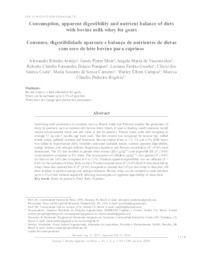Consumption, apparent digestibility and nutrient balance of diets with bovine milk whey for goats.
Consumption, apparent digestibility and nutrient balance of diets with bovine milk whey for goats.
Autoria: ARAÚJO, A. R.; MUIR, J. P.; VASCONCELOS, A. M. de; POMPEU, R. C. F. F.; GUEDES, L. F.; COSTA, C. dos S.; CARNEIRO, M. S. de S.; CAMPOS, W. E.; ROGERIO, M. C. P.
Resumo: Abstract: Increasing milk production in countries such as Brazil, India and Pakistan implies the generation of dairy by-products such as nutrient-rich bovine whey which, if used in feeding small ruminants would reduce environmental waste and add value to this by-product. Twenty entire male kids weighing an average 17 kg and 5 months age were used. The diet control was composed by Aruana hay, milled whole maize, pelleted soybean and limestone. Bovine cheese whey at 1.5; 3.0 and 4.5% (DM basis) was added to experimental diets. Variables measured included intake, nutrient apparent digestibility, energy balance, and nitrogen balance. Regression equations and Pearson correlations (P ? 0.05) were determined. The 3% diet resulted in greater ether extract (EE) (g/kg0.75) and digestible EE (P ? 0.05) concentrations compared to 0% whey. The consumption of cellulose (g/kg0.75) was greater (P ? 0.05) for kids on the 3.0% diet compared to 0 or 1.5%. Nutrient apparent digestibility was not affected (P > 0.05) by the inclusion of whey. Kids on the 4.5% diet excreted more (P - 0.05) fecal N than those fed no whey; these also retained less N (P ? 0.05) compared to animals fed 3.0% or less whey in their diet. All diets resulted in positive energy and nitrogen balances. Bovine whey can be included in male kid diets up to 4.5% of diet without negatively affecting consumption or apparent digestibility of those diets. [Consumo, digestibilidade aparente e balanço de nutrientes de dietas com soro de leite bovino para caprinos].
Ano de publicação: 2020
Tipo de publicação: Artigo de periódico
Unidade: Embrapa Caprinos e Ovinos
Observações
1 - Por padrão são exibidas publicações dos últimos 20 anos. Para encontrar publicações mais antigas, configure o filtro ano de publicação, colocando o ano a partir do qual você deseja encontrar publicações. O filtro está na coluna da esquerda na busca acima.
2 - Para ler algumas publicações da Embrapa (apenas as que estão em formato ePub), é necessário ter, no celular ou computador, um desses softwares gratuitos. Sistemas Android: Google Play Livros; IOS: iBooks; Windows e Linux: software Calibre.
Acesse outras publicações
Acesse a Base de Dados da Pesquisa Agropecuária (BDPA) para consultar o acervo completo das bibliotecas da Embrapa.

